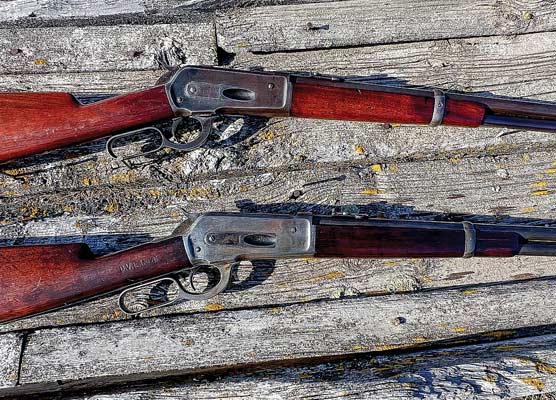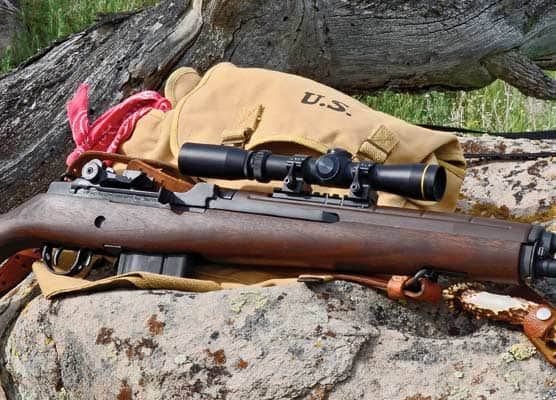Saddle Ring Carbines
Automobiles Made More Than Horses Obsolete
Growing up back east, two things caught my imagination early on — guns and horses, both of which were not plentiful there. So, as soon as I was able, the logical thing was to move west where both could be enjoyed to the fullest. Of course, the natural path was eventually I’d discover the genre of firearm most associated with horses — the saddle ring carbine (SRC).
History
Such were produced by repeating rifle manufacturers starting with the Winchester Model 1866 and following through with all their lever guns models developed in the 19th century. However, it seems SRCs were most popular in the pistol-cartridge models. In the 1880s Marlin, Colt and Whitney/Kennedy and others followed. Actually, commercial firearms manufacturers did not pioneer saddle ring carbines. The horse cavalry did, but that’s another story.
What exactly is an SRC? They are lighter and shorter than standard rifles. It seems 20″ round barrels were standard but on special order, barrels as short as 12″ could be obtained from Winchesters. Whereas rifles had crescent steel buttplates, SRCs had wider, less-curved steel buttplates. Rifles had steel forend caps but SRCs had steel barrel bands. Sights were different also.
Rifles had buckhorn rear sights with stepped sliders for elevation and front sights dovetailed to barrels. SRCs had rear sights of a ladder style. When flat, there was a notched blade but when flipped up, there was another blade to slide up for elevation changes. Early on, SRC front sights were part of the front barrel band but later they were a stud atop the barrel.
Then, there is the defining part making the carbine an SRC — a stud attached to the receiver’s left side containing a ring. Its purpose was a means to attach the carbine to a horse’s saddle so the two would hopefully stay together.
In an era when personal travel, aside from river boats and trains, was by animal power, every pound counted. When traveling by horseback such was even truer. Consider this: A Model 1873 rifle weighed about 8 ½ to 9 lbs. but a carbine cut the weight about 2 lbs. That was considered very desirable. My first horseback hunting with a 10-lb. Sharps rifle proved it to me. I started out walking, leading the horse with the rifle in a scabbard on its right side. When I looked back, the rifle was pulling my saddle off to the same side.
Marlin and Colt even made “baby carbines” that were extra light. I’ve had one of each and they didn’t even hit 5 lbs.
Wearing Only A Thong …
Decades back at Montana gun shows you would often see saddle ring carbines with a simple length of leather thong (boot lace) tied in the ring. I often wondered how it could possibly help keep the carbine secured to a saddle. Well, it would not. Collectors would put those thongs in the rings to keep them from marring the receivers’ finish when being handled.
A simple piece of boot lace wasn’t strong enough to keep a carbine attached very long to a saddle on a moving half-ton animal. What horsemen of old used was a thin strap of strong leather. Even then, it seemed to me a bare carbine dangling from a saddle’s horn would beat the animal and the rider badly. Never mind it would get so filthy as to be dysfunctional.
Of course, they didn’t just dangle loosely and weren’t completely exposed to the elements. I’ve seen old photos of carbines in leather or cloth pouches hanging from saddle horns, not only secured by leather straps through saddle rings but also tied down with saddle strings. I imagine the innovation of saddle scabbards was a relief to armed horse travelers.
The End Is Near
SRCs didn’t have a long life. As said, commercially they began in 1866 and in 1927 Winchester dropped saddle rings because automobiles had made them obsolete. In their heyday, SRCs actually cost less than standard rifles. Winchester’s 1899 catalog has them priced $1.50 less than rifles. Today if you see an SRC sitting next to a rifle of the same make and both in comparable condition, the SRC will be priced higher.
Where modern shooters are lucky is manufacturers in Italy and Japan are producing very good quality Winchester SRC copies. Collectively I’ve had replica and original SRCs chambered as .25-20, .32-20, .32-40 .38 Special, .357 Magnum, .38-40, .38-55, .44-40 and .45-70. Back when we shot cowboy action competitions, Yvonne liked her Model 1866 .38 Special due to its mild recoil. In my old age I like the gentle ones too, and just picked up a nifty .32-20 Model ’92.









